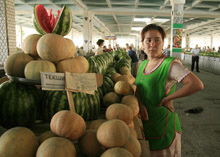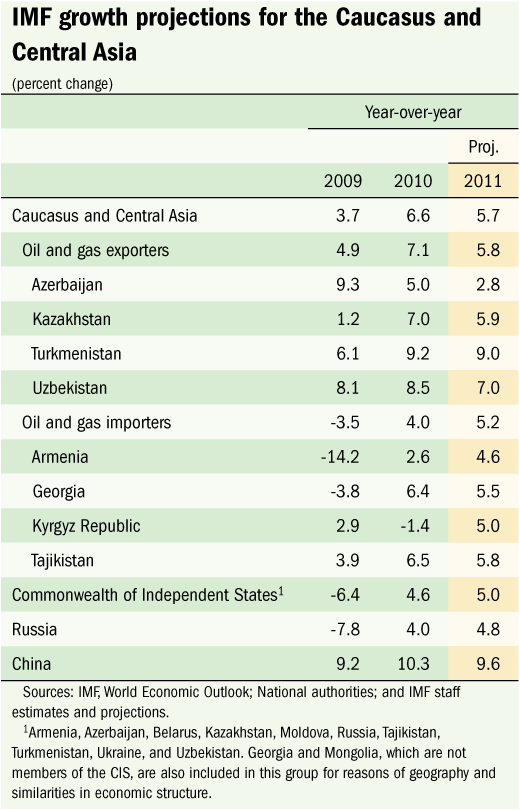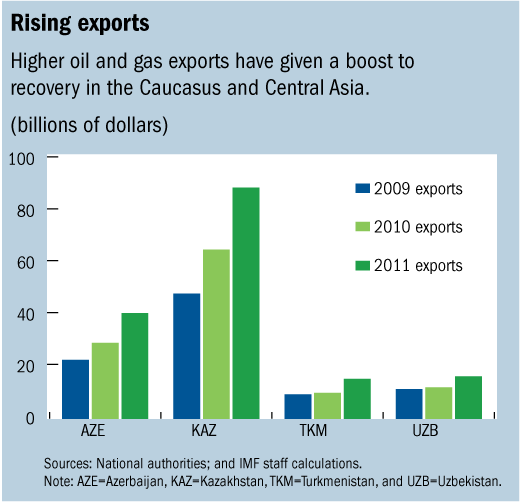
Typical street scene in Santa Ana, El Salvador. (Photo: iStock)
IMF Survey: Caucasus, Central Asia Rebound, But Inflation Poses Risk
April 28, 2011
- Recovery driven by commodity exports, public investment
- But higher inflation is leading to government spending pressures
- Countries need to develop targeted, cost-effective safety nets for the poor
Countries in the Caucasus and Central Asia (CCA) are seeing a second year of strong growth following the crisis, but the region must tackle inflation and other issues if it is to sustain the recovery, the IMF says in its latest forecast for the region.

Fruit vendor in Samarkand, Uzbekistan, an oil-exporting country that is seeing impressive growth but also higher food prices (photo: Maria Golovnina/Reuters)
REGIONAL ECONOMIC OUTLOOK
The Regional Economic Outlook for Middle East and Central Asia notes that the region’s post-crisis recovery took hold in 2010, with growth registering 6½ percent, up from 3½ percent in 2009. This unexpectedly strong rebound was driven by commodity exports and public investment, with oil and gas exporters enjoying particularly strong growth.
In 2011, as oil and gas production growth slows, the region’s expansion is expected to moderate to 5¾ percent, IMF Middle East and Central Asia Department Deputy Director David Owen told reporters at an April 28 press briefing on the report in Tbilisi, Georgia.
“To sustain the recovery, policymakers in the Caucasus and Central Asia will need to address rising inflation, respond to social pressures arising from high food prices without threatening fiscal stability, and restore the health of banking systems,” Owen said.

Road to recovery
In 2010, the region’s oil and gas exporters (Azerbaijan, Kazakhstan, Turkmenistan, and Uzbekistan) experienced 7 percent growth and improved their current account position by 5½ percentage points of GDP. Although the expansion was lower—at 4 percent—in oil and gas importing countries (Armenia, Georgia, the Kyrgyz Republic and Tajikistan), these countries’ external positions also strengthened, aided by higher mineral and metal prices. Foreign exchange reserves generally increased, particularly in Azerbaijan and Kazakhstan, where there was also a significant accumulation of assets in sovereign wealth funds, the report says.
Despite clear signs of recovery, remittances—a key source of inflows in Armenia, the Kyrgyz Republic, and Tajikistan—picked up from 2009, but did not return to 2008 levels. Similarly, in Georgia and Kazakhstan, foreign investment continued to be well below pre-crisis levels. And private demand remains subdued in countries like Kazakhstan, restrained by weak financial systems and ongoing deleveraging, the report notes.
Since the crisis, financial sector difficulties have continued to plague the region. High and rising nonperforming loans have impaired bank financial positions and pose risks to capital adequacy. In Kazakhstan, the Kyrgyz Republic, and Tajikistan, despite ample bank liquidity, banks are unwilling to extend loans to avoid further risks to their balance sheets. Uncertainties surrounding the stability of funding sources and provisioning needs have increased incentives to maintain cash reserves and restrain lending activity. Restoring the health of banking systems—and strengthening regulatory, supervisory, and governance frameworks for the sector—is thus a key priority, the IMF report stresses.
The CCA region is also coping with the emerging problem of inflation, which adversely affects the poor. With global fuel and food prices expected to increase by 18 and 15 percent, respectively, in 2011, average inflation in the region is projected to increase to around 10 percent this year. Annual inflation, as measured by the consumer price index, is approaching double digits in Azerbaijan and Kazakhstan, and has already passed this threshold in the region’s other countries, except for Turkmenistan.
All CCA countries are facing pressures to respond to the inflation upsurge, which may involve increases in public spending, ranging from the use of strategic grain reserves to targeted transfers, more generalized subsidies, and possible wage and pension hikes. These pressures for higher spending are delaying fiscal tightening in some countries, and governments’ efforts to prioritize and improve the quality of public expenditure will be crucial, the report notes.

Risks ahead
Risks to the outlook are mixed. Growth could be stronger if the upward movement in oil prices continues, with higher exports and investment. CCA oil and gas importers would face a larger import bill, but would also benefit from higher remittances from Russia and greater foreign investment.
Heightened inflation expectations, lingering financial sector problems, and a possible deterioration of the global economy could all potentially hurt the country’s growth prospects. The sociopolitical environment also poses risks because of high poverty levels and perceptions of low voice and accountability in some countries.
Policy challenges
Policymakers in the CCA face the tricky balance of trying to maintain macroeconomic stability while protecting the most vulnerable, the IMF says. This will involve addressing several pressing challenges:
• the surge of inflation with risks of inflationary expectations becoming entrenched;
• an upsurge of social pressures to increase fiscal spending, which may generate threats to macroeconomic stability; and
• the poor quality of bank portfolios, which restrains credit growth and effective intermediation.
The IMF report recommends that, over the long term, the region’s policymakers seek to create jobs and reduce poverty by working toward:
• developing adequate safety nets;
• increasing the role of the private sector;
• diversifying economies away from natural resources;
• achieving greater regional synergies; and
improving the business environment through enhanced transparency, governance and institutional quality.


